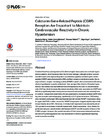Calcitonin Gene-Related Peptide (CGRP) Receptors Are Important to Maintain Cerebrovascular Reactivity in Chronic Hypertension
dc.contributor.author
Wang, Zhenghui
dc.contributor.author
Martorell, Belen C.
dc.contributor.author
Wälchli, Thomas
dc.contributor.author
Vogel, Olga
dc.contributor.author
Fischer, Jan
dc.contributor.author
Born, Walter
dc.contributor.author
Vogel, Johannes
dc.date.accessioned
2018-10-18T08:00:14Z
dc.date.available
2017-06-11T17:18:29Z
dc.date.available
2018-10-18T08:00:14Z
dc.date.issued
2015-04-10
dc.identifier.issn
1932-6203
dc.identifier.other
10.1371/journal.pone.0123697
en_US
dc.identifier.uri
http://hdl.handle.net/20.500.11850/100615
dc.identifier.doi
10.3929/ethz-b-000100615
dc.description.abstract
Cerebral blood flow autoregulation (CA) shifts to higher blood pressures in chronic hypertensive patients, which increases their risk for brain damage. Although cerebral vascular smooth muscle cells express the potent vasodilatatory peptides calcitonin gene-related peptide (CGRP) and adrenomedullin (AM) and their receptors (calcitonin receptor-like receptor (Calclr), receptor-modifying proteins (RAMP) 1 and 2), their contribution to CA during chronic hypertension is poorly understood. Here we report that chronic (10 weeks) hypertensive (one-kidney-one-clip-method) mice overexpressing the Calclr in smooth muscle cells (CLR-tg), which increases the natural sensitivity of the brain vasculature to CGRP and AM show significantly better blood pressure drop-induced cerebrovascular reactivity than wt controls. Compared to sham mice, this was paralleled by increased cerebral CGRP-binding sites (receptor autoradiography), significantly in CLR-tg but not wt mice. AM-binding sites remained unchanged. Whereas hypertension did not alter RAMP-1 expression (droplet digital (dd) PCR) in either mouse line, RAMP-2 expression dropped significantly in both mouse lines by about 65%. Moreover, in wt only Calclr expression was reduced by about 70% parallel to an increase of smooth muscle actin (Acta2) expression. Thus, chronic hypertension induces a stoichiometric shift between CGRP and AM receptors in favor of the CGRP receptor. However, the parallel reduction of Calclr expression observed in wt mice but not CLR-tg mice appears to be a key mechanism in chronic hypertension impairing cerebrovascular reactivity.
en_US
dc.format
application/pdf
en_US
dc.language.iso
en
en_US
dc.publisher
PLOS
dc.rights.uri
http://creativecommons.org/licenses/by/4.0/
dc.title
Calcitonin Gene-Related Peptide (CGRP) Receptors Are Important to Maintain Cerebrovascular Reactivity in Chronic Hypertension
en_US
dc.type
Journal Article
dc.rights.license
Creative Commons Attribution 4.0 International
ethz.journal.title
PLoS ONE
ethz.journal.volume
10
en_US
ethz.journal.issue
4
en_US
ethz.journal.abbreviated
PLoS ONE
ethz.pages.start
e0123697
en_US
ethz.size
15 p.
en_US
ethz.version.deposit
publishedVersion
en_US
ethz.identifier.wos
ethz.publication.place
San Francisco, CA
ethz.publication.status
published
en_US
ethz.date.deposited
2017-06-11T17:19:22Z
ethz.source
ECIT
ethz.identifier.importid
imp593653265b54e74871
ethz.ecitpid
pub:157965
ethz.eth
yes
en_US
ethz.availability
Open access
en_US
ethz.rosetta.installDate
2017-07-14T16:44:09Z
ethz.rosetta.lastUpdated
2024-02-02T06:23:54Z
ethz.rosetta.versionExported
true
ethz.COinS
ctx_ver=Z39.88-2004&rft_val_fmt=info:ofi/fmt:kev:mtx:journal&rft.atitle=Calcitonin%20Gene-Related%20Peptide%20(CGRP)%20Receptors%20Are%20Important%20to%20Maintain%20Cerebrovascular%20Reactivity%20in%20Chronic%20Hypertension&rft.jtitle=PLoS%20ONE&rft.date=2015-04-10&rft.volume=10&rft.issue=4&rft.spage=e0123697&rft.issn=1932-6203&rft.au=Wang,%20Zhenghui&Martorell,%20Belen%20C.&W%C3%A4lchli,%20Thomas&Vogel,%20Olga&Fischer,%20Jan&rft.genre=article&rft_id=info:doi/10.1371/journal.pone.0123697&
Files in this item
Publication type
-
Journal Article [129049]

